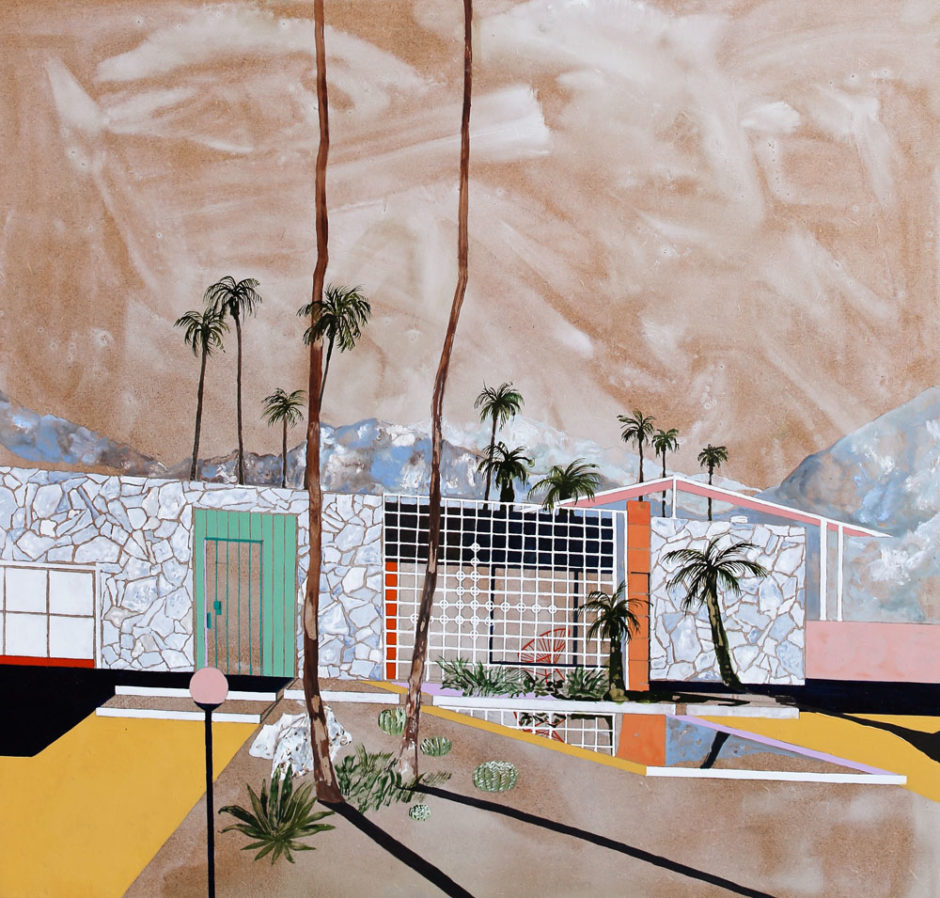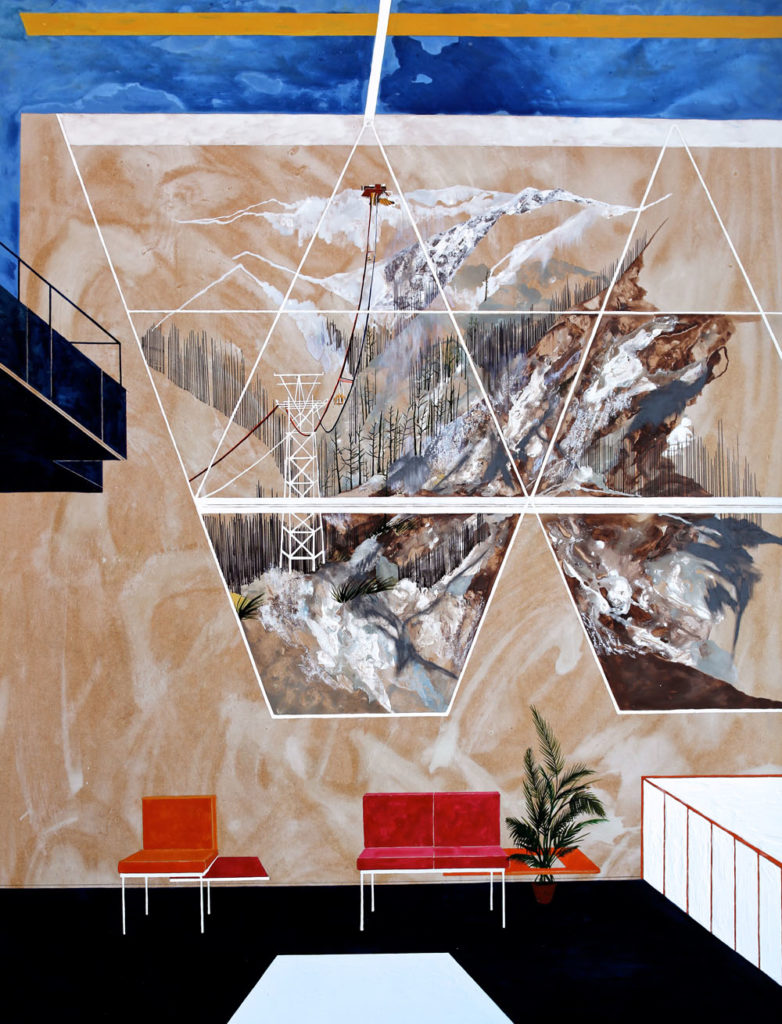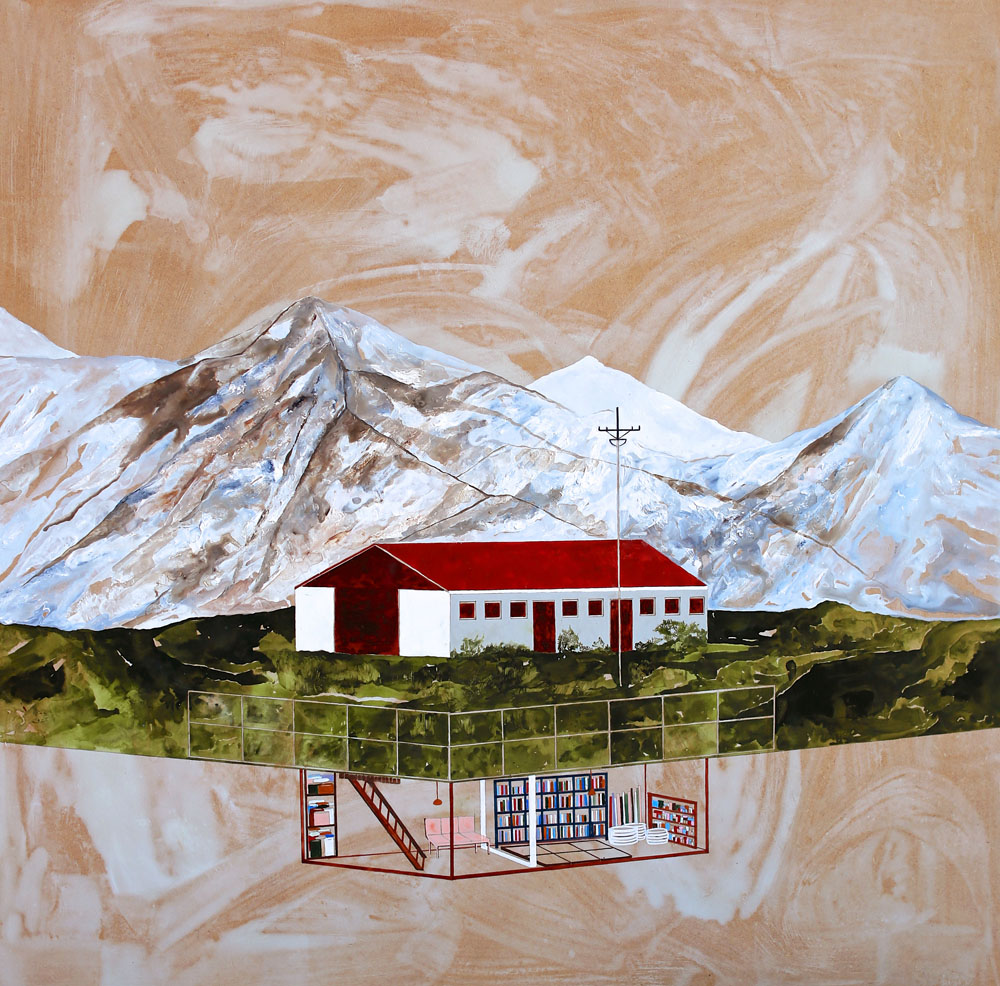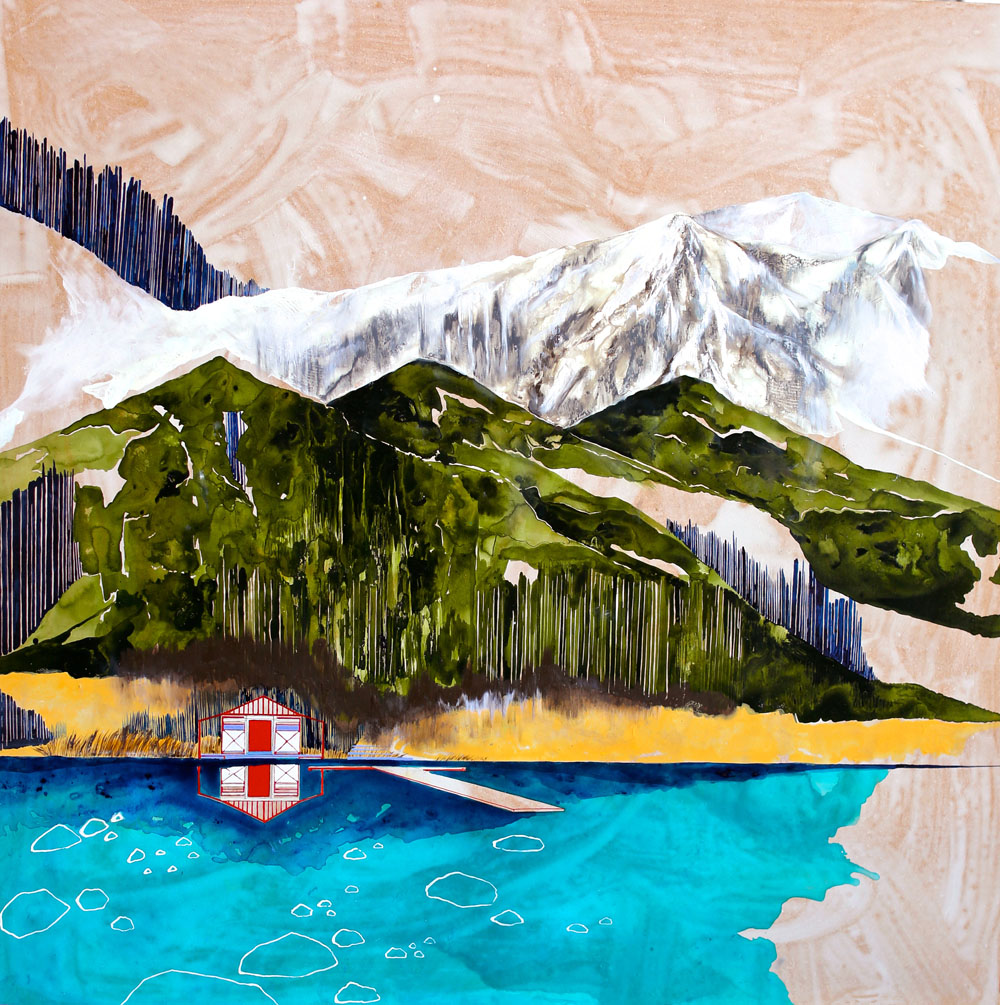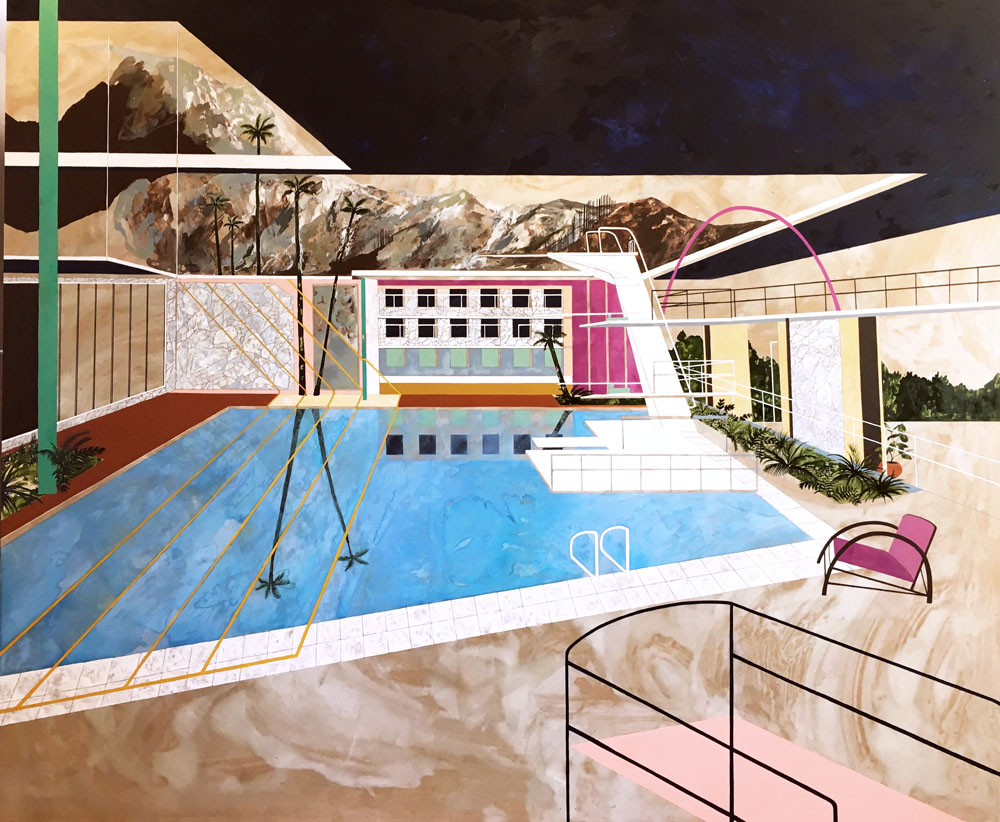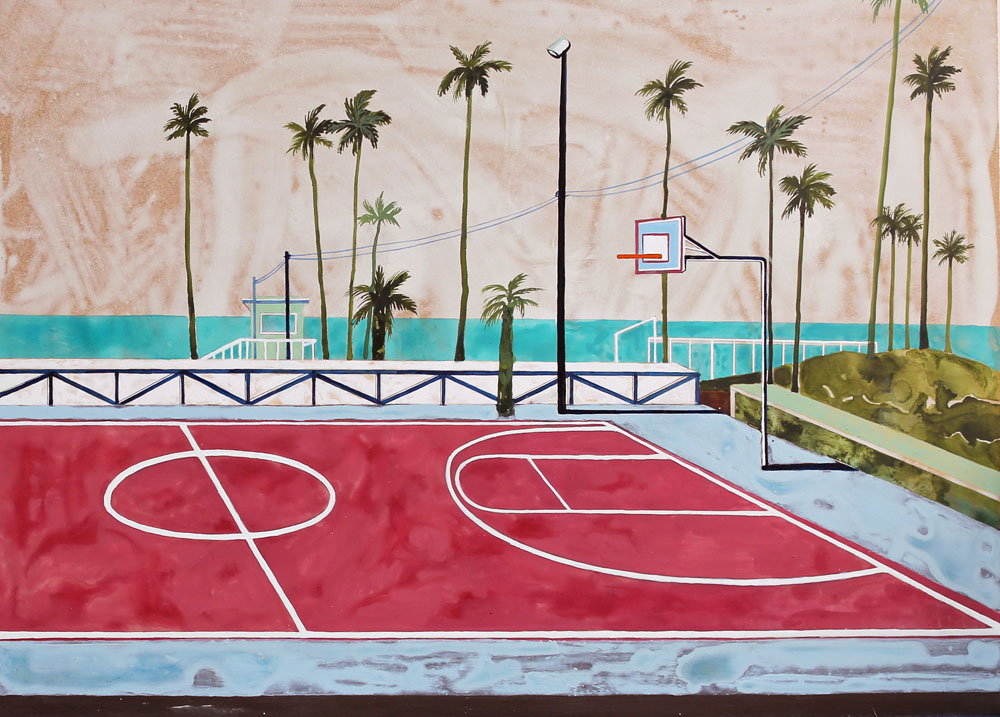You find yourself sat in an austere lobby in a modernist building. In front of you is a baby blue table top; above and to the left a dark blue suspended balcony; to the right a white counter of some kind, or perhaps it’s a translucent ceiling jutting up from an unseen space below. Opposite you are three red chairs – a pair and a single seat, with small side tables projecting out from underneath. A fern in a plant pot emerges through a purposely designed hole in one of the tables, taking the edge off the otherwise relentlessly harsh straight lines of the interior space.
Dominating the wall behind the chairs, however, is a vast polygonal window composed of triangular and trapezoidal panes divided by thin white frames. Well, one might presume it is a window, but it could just as easily be a mural, for the wall – borrowing the light brown colour of the painting’s exposed wooden ground with abstract patterns of translucent white gesso loosely washed over the top – continues out into the landscape beyond. The landscape is decidedly dramatic, peppered with bare trees and covered in rugged grey and brown mountainous rocks speckled with snow that increases as the mountaintops recede. At the very highest point, on the horizon, a cabin can be seen with cable car wires swooping down through the valley towards us, a car dangling precipitously as it approaches a pylon-like tower in the middle distance. We’re left wondering exactly where we are – the offices of some stylish but anonymous corporation, the reception of an exclusive hotel in an out-of-season ski resort, a remote research laboratory, or perhaps an uber-discreet private hospital of some kind? There is a sense of drama, mystery, adventure, and above all, illusion in this imposing painting, Aerial Tramway (2017), and a band of dark blue sky at the very top of the image implies we might actually be looking at a set or a screen of some kind, exposed to the elements above.
The combination of mountainous terrain and mysterious buildings continues in several of East London-based artist Charlotte Keates’s recent works, including Iron Forest (2017), As Glaciers Melt (2017), and Under the Surface (2017). In Iron Forest, a wooden hut with panels painted camel and red sits half-buried in snow on the edge of a lake. Behind it, a stark, vertiginous wall of black rods seems to hold back the mountain behind, its grey-tinged snow-covered rocks and ravines rendered as if billowing clouds. The reflection in the lake turns the mountain to an icy black shadow, with a large shard of grey-white ice floating on the surface. One wonders what the hut is used for – an emergency shelter for mountaineers? A cabin for fishermen in the warmer seasons? A research station for scientists? The scene has all the ingredients of the sublime – an epic, foreboding landscape that conveys the sheer awesome power of nature at work on a grand scale as mountains, lakes and ice form and change. Our human presence within it seems vulnerable, feeble almost, in comparison, the pathetic scale of our bodies and structures humbled by mighty geological forces.
That humankind, especially mankind, is managing to upset the balance of the natural world, however, is alluded to by Keates in a work like As Glaciers Melt, which shows a beach hut or chalet accompanied by a simple jetty beside a turquoise sea, with a golden sandy shore and green hills for a backdrop. Behind them only snowy mountains and empty sky. The tacit implication is that as the ice melts, warmer weather comes and the water levels rise. While we might enjoy the warmer climate, it is ultimately bad news for everyone. That Keates is more than aware of our capacity to destroy the natural world completely, though, can be seen in Under the Surface, which depicts a single-storey building in the middle of a green craggy field against a barely snow-covered mountain range. As if in an architect’s drawing, the artist shows us a cut-away view of what’s going on underground. Beneath the building there is a deep basement, which at first appears like a pleasant living space with books, pouffes and a sofa. But, as Keates explains, what is depicted is a purpose-built nuclear bunker filled with tins, cans and bottles to allow its inhabitants to survive for a period of six months in the event of nuclear war. Above ground, we would have no idea of what lies beneath – we can’t even be sure what kind of building it is – whether residential, commercial or light industrial. What appears a quiet, innocuous landscape scene is revealed by the artist as a site of extreme planning for disaster, apocalypse and Armageddon.
But the outlook is not entirely pessimistic in Keates’s world, for there is also a sense of curiosity, wonder and excitement about what humans can achieve, especially as it is manifested through the built environment. Anyone familiar with Keates’s work will know of her fascination with the myriad materials that are fabricated for use in construction, the seemingly endless variety of surfaces, textures, colours, patterns, shapes and forms that can be used to create buildings and spaces for human use, and the limitless ways in which they can be combined, whether through careful design and planning or agglomeration over time. It would need an architect or someone versed in the technical language of architecture to accurately describe the many complex architectural features that make an appearance in Keates’s paintings, from porticos and patios to balconets and belfries, dormers and dromoses to cantilevers and colonnades. Mostly based on her own photographs, Keates often fuses together lots of elements from different locations, creating hybrid architectural scenarios. Some seem entirely plausible, like everyday places one could easily imagine visiting; others are less quotidian and might only be encountered on holiday or when going somewhere for purposes more out-of-the-ordinary, while others verge on the fantastical and fictional. Indeed, many look like they could be sets from films, plays or computer games, and there is a strong related sense of collage and pastiche in her paintings. This impression of bringing together disparate imagery and fitting it together, like a jigsaw made up of different puzzles, is enhanced by a bold graphic aesthetic, whereby the illusion of three-dimensional space regularly gives way to other formal devices such as line, pattern or flat passages of colour. At a certain moment things that appear architectural turn into purely graphic or decorative motifs with no discernible function in the space depicted. In this way Keates’s images become flights of fancy, leading us into the realms of utopias and dystopias, of ideal spaces and places that fall short of these ideals to varying degrees. While straight lines and acute angles characterise her images, there is also a very painterly, and specifically freely hand-painted, feeling to these works – the closer one gets, the more human they become.
In Keates’s extensive lexicon, we find basketball courts on tropical sea-front esplanades, modernist museums with joyful mosaic façades, observatories based up in the clouds, luxurious swimming pools and private lidos, informal suburban domestic backyards and eerie institutional complexes like empty schools or office blocks. The prevalence of palm trees in Keates’s recent works perhaps comes as no surprise when it is discovered that in summer 2016 she went on a three-month research trip the USA, starting in New York and travelling down the East Coast, before working her way from Palm Springs and Los Angeles right up the West Coast and into Canada. The countless stopping points on this epic road-trip provided her with great swathes of new source material, from mid-century modernism to snow-capped mountain scenery, adding to the sense that we as viewers are privy to the artist’s own architectural odyssey. Endlessly inventive and with a remarkable eye for colour, composition, perspective, pattern and detail, Keates invites us to join her on her ongoing quest to explore the possibilities of the built environment and its place within the natural world.
Words: Matt Price
Charlotte Keates has a solo exhibition, ‘Sojourn’, at Arusha Gallery in Edinburgh until 30 May 2017.
All images © the artist. Courtesy the artist and Arusha Gallery, Edinburgh. Photography by Ian Froome.
Image credits from top:
Charlotte Keates, In the Spotlight, 2017. Acrylic on panel, 64 x 62 cm.
Charlotte Keates, Aerial Tramway, 2017. Acrylic and oil on panel, 160 x 120 cm.
Charlotte Keates, Under the Surface, 2017. Acrylic and oil on panel, 100 x 100 cm.
Charlotte Keates, As Glaciers Melt, 2017. Acrylic and oil on panel, 100 x 100 cm.
Charlotte Keates, Springboard, 2017. Acrylic and oil on panel, 180 x 220 cm.
Charlotte Keates, Way Downtown, 2017. Acrylic on panel, 40 x 64 cm.

